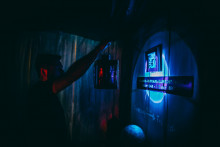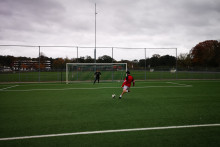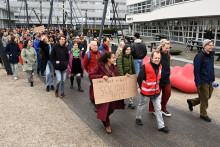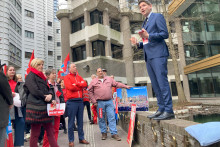The graveyard in the centre of the city is a hotspot for substance abusers instilling an unsafe feeling to passers-by. Which is why the Interaction Technology students were invited to design interactive installations within their Designing Interactive Experiences course.
Robby van Delden, UT researcher and a teacher of the course, explains that one of the goals was to make the history of this site more visible while at the same time increasing the feelings of safety for passers-by. ‘We wanted students to come up with an intervention with a technical edge,’ says Van Delden. ‘Twenty-five students followed the course, resulting in five creative and different prototypes. The assignment was provided by the Historical society of Enschede and Lonneker to make the place and its history more lively.’

The path of life
One of the installations focuses on the path of life by utilising augmented reality (AR). Juliette Hoedemakers (25) explains the concept: ‘By utilising their mobile phone people can walk over this path. During this walk the user experiences four different stages of life in augmented reality. Namely childhood, adulthood, old age and afterlife. For every stage of life, one person who is buried here tells the story. It is an interactive experience and people get questions from the storyteller that corresponds with that stage of life. At the end of the path we put up a sign where people can leave reactions to the experience, we really want the people to think about life and what kind of person they want to be.’
The city fire of 1862 and the butterfly effect
Tucked away in the corner of the graveyard is a group of students that built a time machine. The visitors of this installation get an introduction by Hendrik Smelt who lived during the times of the Enschede Inferno.
Student Eva Maria Veitmaa (23) elaborates on the decision to build a time machine. ‘The time machine takes the visitor back to the 19th century, specifically to the tavern called the Hooiberg where Hendrik Smelt used to come after a day of work. Visitors get a time travelling backpack. Once inside Hendrik Smelt recites a poem about the Enschede inferno, meanwhile the time traveller can press buttons that create sounds which are associated with a pub to create a background to the poem. But if the visitor chooses to press too many buttons, they can actually cause the fire.’
Currently there are two outcomes possible, either the fire does or does not start depending on the input. The idea behind the time machine is that even the smallest of actions can cause a disastrous outcome, explains the student. ‘We utilise four of the five senses in this experience namely, sound, vision (LED Lights), touch through vibrating haptic feedback (backpack) and smell by utilising a smoke machine if the user starts the fire. The only sense we didn’t manage was taste, but you can’t have everything.’
Have you missed yesterday’s exhibition? ‘Some of the installations will be at the graveyard permanently while others are only there at specific times of the year such as Halloween,’ says Van Delden. ‘We hope that these installations will also increase the amount of visitors to the site.’










